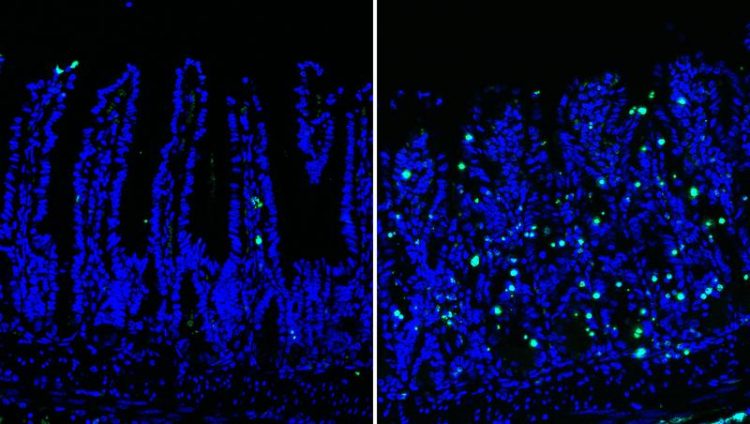Intestinal health: Dresden research team identifies enzyme essential for stem cell survival

Healthy (right) vs diseased (left) bowel: Extensive DNA damage (green) within the intestinal epithelium leads to inflammatory cell death and disrupts intestinal homeostasis © CRTD
Study results contribute to the understanding of intestinal regeneration and prevention of intestinal inflammation
The intestinal epithelium is the inner layer of the intestinal wall, which separates host tissue from the intestinal microbiota. This layer of cells plays a crucial role in water, electrolyte and nutrient absorption, while limiting the entry of bacteria, viruses, fungi, toxins and antigens into host tissue to ensure intestinal homeostasis.
The diverse functions carried out by the intestinal epithelium are supported by multiple specialised intestinal epithelial cells, which are replaced every three to five days from a pool of intestinal stem cells. This makes the intestinal epithelium one of the most rapidly renewing tissues in adult mammals.
Which pathways govern intestinal epithelial differentiation under constitutive conditions? Epithelial differentiation is largely controlled by the tissue-specific activity of transcription factors. Access to DNA is provided by accessible chromatin (euchromatin), while compacted heterochromatin limits access of transcription factors to DNA.
Researchers at the TU Dresden Center for Regenerative Therapies (CRTD) have now investigated the significance of the regulation of heterochromatin formation in the intestinal epithelium and published their findings in the renowned international scientific journal Gut.
In their study, Prof. Sebastian Zeißig’s team demonstrated the essential role of the SETDB1 protein involved in heterochromatin formation during intestinal epithelial cells differentiation, and its importance in preventing inflammation.
The scientists observed in mice the consequences of the enzyme loss in the intestinal stem cells: Endogenous retroviruses, which represent a relevant part of the human genome, accumulate within a few days, which leads to DNA damage, inflammatory cell death, and loss of intestinal epithelial stem cells as well as of differentiated epithelial cells.
This limits the absorption of fluid and nutrients, causes intestinal inflammation and inevitably leads to death within a few days.
“Our study reveals a fundamental importance of SETDB1 and heterochromatin formation in the maintenance of epithelial genome stability and the control of intestinal homeostasis,” explains Prof Sebastian Zeißig, CRTD research group leader and physician at the Medical Clinic I of the University Hospital Carl Gustav Carus Dresden. “It remains to be seen whether mutations in this gene can also contribute to intestinal inflammation in humans, for example, in inflammatory bowel diseases.”
The study was funded by TU Dresden / CRTD within the German Excellence Initiative and supported by the DRESDEN-concept Genome Center and the Electron and Light Microscopy Facilities of TU Dresden CMCB Technology Platform.
Prof. Sebastian Zeißig
Email: sebastian.zeissig@tu-dresden.de
GUT: “SETDB1 is required for intestinal epithelial differentiation and the prevention of intestinal inflammation”, authors: Lea Južnić, Kenneth Peuker, Anne Strigli, Mario Brosch, Alexander Herrmann, Robert Häsler, Michael Koch, Liz Matthiesen, Yvonne Zeißig, Britt-Sabina Löscher, Alexander Nuber, Gunnar Schotta, Volker Neumeister, Triantafyllos Chavakis, Thomas Kurth, Mathias Lesche, Andreas Dahl, Anne von Mässenhausen, Andreas Linkermann, Stefan Schreiber, Konrad Aden, Philip Rosenstiel, Andre Franke, Jochen Hampe, Sebastian Zeißig
Media Contact
More Information:
http://www.tu-dresden.deAll latest news from the category: Life Sciences and Chemistry
Articles and reports from the Life Sciences and chemistry area deal with applied and basic research into modern biology, chemistry and human medicine.
Valuable information can be found on a range of life sciences fields including bacteriology, biochemistry, bionics, bioinformatics, biophysics, biotechnology, genetics, geobotany, human biology, marine biology, microbiology, molecular biology, cellular biology, zoology, bioinorganic chemistry, microchemistry and environmental chemistry.
Newest articles

High-energy-density aqueous battery based on halogen multi-electron transfer
Traditional non-aqueous lithium-ion batteries have a high energy density, but their safety is compromised due to the flammable organic electrolytes they utilize. Aqueous batteries use water as the solvent for…

First-ever combined heart pump and pig kidney transplant
…gives new hope to patient with terminal illness. Surgeons at NYU Langone Health performed the first-ever combined mechanical heart pump and gene-edited pig kidney transplant surgery in a 54-year-old woman…

Biophysics: Testing how well biomarkers work
LMU researchers have developed a method to determine how reliably target proteins can be labeled using super-resolution fluorescence microscopy. Modern microscopy techniques make it possible to examine the inner workings…





















